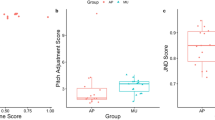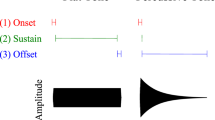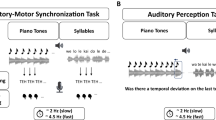Abstract
Pitch conveys critical information in speech, music and other natural sounds, and is conventionally defined as the perceptual correlate of a sound’s fundamental frequency (F0). Although pitch is widely assumed to be subserved by a single F0 estimation process, real-world pitch tasks vary enormously, raising the possibility of underlying mechanistic diversity. To probe pitch mechanisms, we conducted a battery of pitch-related music and speech tasks using conventional harmonic sounds and inharmonic sounds whose frequencies lack a common F0. Some pitch-related abilities—those relying on musical interval or voice recognition—were strongly impaired by inharmonicity, suggesting a reliance on F0. However, other tasks, including those dependent on pitch contours in speech and music, were unaffected by inharmonicity, suggesting a mechanism that tracks the frequency spectrum rather than the F0. The results suggest that pitch perception is mediated by several different mechanisms, only some of which conform to traditional notions of pitch.
This is a preview of subscription content, access via your institution
Access options
Access Nature and 54 other Nature Portfolio journals
Get Nature+, our best-value online-access subscription
$29.99 / 30 days
cancel any time
Subscribe to this journal
Receive 12 digital issues and online access to articles
$119.00 per year
only $9.92 per issue
Buy this article
- Purchase on Springer Link
- Instant access to full article PDF
Prices may be subject to local taxes which are calculated during checkout








Similar content being viewed by others
References
Helmholtz, H. L. F. On the Sensations of Tone (Longmans, Green, & Co., London, 1875).
Rayleigh, W. S. Theory of Sound (Macmillan, London, 1896).
von Békésy, G. Experiments in Hearing (McGraw-Hill, New York, NY, 1960).
Plack, C., Oxenham, A., Fay, R. & Popper, A. Pitch: Neural Coding and Perception Vol. 24 (Springer, New York, NY, 2005).
DeCheveigné, A. in Pitch: Neural Coding and Perception (eds Plack, C. J., Oxenham, A. J., Fay, R. & Popper, A.) 169–233 (Springer, New York, NY, 2005).
Licklider, J. C. R. ‘Periodicity’ pitch and ‘place’ pitch. J. Acoust. Soc. Am. 26, 945 (1954).
Schouten, J. F., Ritsma, R. J. & Cardozo, B. L. Pitch of the residue. J. Acoust. Soc. Am. 34, 1418–1424 (1962).
Meddis, R. & Hewitt, M. J. Virtual pitch and phase sensitivity of a computer model of the auditory periphery. I: Pitch identification. J. Acoust. Soc. Am. 89, 2866–2882 (1991).
Cariani, P. & Delgutte, B. Neural correlates of the pitch of complex tones. I. Pitch and pitch salience. J. Neurophysiol. 76, 1698–1716 (1996).
Shamma, S. & Klein, D. The case of the missing pitch templates: how harmonic templates emerge in the early auditory system. J. Acoust. Soc. Am. 107, 2631–2644 (2000).
Goldstein, J. L. An optimum processor theory for the central formation of the pitch of complex tones. J. Acoust. Soc. Am. 54, 1496–1516 (1973).
Terhardt, E. Calculating virtual pitch. Hear. Res. 1, 155–182 (1979).
Kaernbach, C. & Demany, L. Psychophysical evidence against the autocorrelation theory of auditory temporal processing. J. Acoust. Soc. Am. 104, 2298–2306 (1998).
Bernstein, J. G. W. & Oxenham, A. J. The relationship between frequency selectivity and pitch discrimination: sensorineural hearing loss. J. Acoust. Soc. Am. 120, 3929–3945 (2006).
Bendor, D. & Wang, X. The neuronal representation of pitch in primate auditory cortex. Nature 436, 1161–1165 (2005).
Feng, L. & Wang, X. Harmonic template neurons in primate auditory cortex underlying complex sound processing. Proc. Natl Acad. Sci. USA 114, E840–848 (2017).
Fishman, Y. I., Micheyl, C. & Steinschneider, M. Neural representation of harmonic complex tones in primary auditory cortex of the awake monkey. J. Neurosci. 33, 10312–10323 (2013).
Bizley, J. K., Walker, K. M. M., King, A. J. & Schnupp, J. W. H. Neural ensemble codes for stimulus periodicity in auditory cortex. J. Neurosci. 30, 5078–5091 (2010).
Patterson, R. D., Uppenkamp, S., Johnsrude, I. S. & Griffiths, T. D. The processing of temporal pitch and melody information in auditory cortex. Neuron 36, 767–776 (2002).
Penagos, H., Melcher, J. R. & Oxenham, A. J. A neural representation of pitch salience in nonprimary human auditory cortex revealed with functional magnetic resonance imaging. J. Neurosci. 24, 6810–6815 (2004).
Norman-Haignere, S., Kanwisher, N. & McDermott, J. H. Cortical pitch regions in humans respond primarily to resolved harmonics and are located in specific tonotopic regions of anterior auditory cortex. J. Neurosci. 33, 19451–19469 (2013).
Allen, E. J., Burton, P. C., Olman, C. A. & Oxenham, A. J. Representations of pitch and timbre variation in human auditory cortex. J. Neurosci. 37, 1284–1293 (2017).
Tang, C., Hamilton, L. S. & Chang, E. F. Intonational speech prosody encoding in the human auditory cortex. Science 801, 797–801 (2017).
Faulkner, A. Pitch discrimination of harmonic complex signals: residue pitch or multiple component discriminations? J. Acoust. Soc. Am. 78, 1993–2004 (1985).
Moore, B. C. J. & Glasberg, B. R. Frequency discrimination of complex tones with overlapping and non-overlapping harmonics. J. Acoust. Soc. Am. 87, 2163–2177 (1990).
Micheyl, C., Divis, K., Wrobleski, D. M. & Oxenham, A. J. Does fundamental-frequency discrimination measure virtual pitch discrimination? J. Acoust. Soc. Am. 128, 1930–1942 (2010).
Micheyl, C., Ryan, C. M. & Oxenham, A. J. Further evidence that fundamental-frequency difference limens measure pitch discrimination. J. Acoust. Soc. Am. 131, 3989–4001 (2012).
Latinus, M. & Belin, P. Human voice perception. Curr. Biol. 21, R143–145 (2011).
McDermott, J. H. & Oxenham, A. J. Music perception, pitch, and the auditory system. Curr. Opin. Neurobiol. 18, 452–463 (2008).
Roberts, B. & Holmes, S. D. Grouping and the pitch of a mistuned fundamental component: effects of applying simultaneous multiple mistunings to the other harmonics. Hear. Res. 222, 79–88 (2006).
Houtsma, A. J. M. & Smurzynski, J. Pitch identification and discrimination for complex tones with many harmonics. J. Acoust. Soc. Am. 87, 304 (1990).
Shackleton, T. M. & Carlyon, R. P. The role of resolved and unresolved harmonics in pitch perception and frequency modulation discrimination. J. Acoust. Soc. 95, 3529–3540 (1994).
Micheyl, C., Delhommeau, K., Perrot, X. & Oxenham, A. J. Influence of musical and psychoacoustical training on pitch discrimination. Hear. Res. 219, 36–47 (2006).
Pressnitzer, D. & Patterson, R. D. in Physiological and Psychophysical Bases of Auditory Function (eds Breebart. D. J., Houtsma, A. J. M., Kohlrausch, A., Prijs, V. F. & Schoonoven, R.) 97–104 (Shaker Publishing, Maastricht, 2001).
Norman-Haignere, S. & McDermott, J. H. Distortion products in auditory fMRI research: measurements and solutions. NeuroImage 129, 401–413 (2016).
Dowling, W. J. & Fujitani, D. S. Contour, interval, and pitch recognition in memory for melodies. J. Acoust. Soc. Am. 49, 524–531 (1971).
Kawahara, H. STRAIGHT, exploitation of the other aspect of VOCODER: perceptually isomorphic decomposition of speech sounds. Acoust. Sci. Technol. 27, 349–353 (2006).
Kawahara, H. et al. TANDEM-STRAIGHT: a temporally stable power spectral representation for periodic signals and applications to interference-free spectrum, F0, and aperiodicity estimation. Sadhana 36, 713–722 (2011).
McDermott, J. H., Ellis, D. P. & Kawahara, H. Inharmonic speech: a tool for the study of speech perception and separation. SAPA@ Interspeech 114–117 (2012).
Sloboda, J. A. The Musical Mind: The Cognitive Psychology of Music (Oxford Univ. Press, Oxford, 1985).
Peretz, I., Champod, A. S. & Hyde, K. Varieties of musical disorders: the Montreal battery of evaluation of amusia. Ann. NY Acad. Sci. 999, 58–75 (2003).
Temperley, D. A probabilistic model of melody perception. Cogn. Sci. 32, 418–444 (2008).
McDermott, J. H., Keebler, M. V., Micheyl, C. & Oxenham, A. J. Musical intervals and relative pitch: frequency resolution, not interval resolution, is special. J. Acoust. Soc. Am. 128, 1943–1951 (2010).
Garofolo, J. S. et al. TIMIT Acoustic–Phonetic Continuous Speech Corpus LDC93S1 (Linguistic Data Consortium, PA, 1993).
Marques, C., Moreno, S., Castro, S. L. & Besson, M. Musicians detect pitch violation in a foreign language better than nonmusicians: behavioral and electrophysiological evidence. J. Cogn. Neurosci. 19, 1453–1463 (2007).
Tervaniemi, M., Just, V., Koelsch, S., Widmann, A. & Schröger, E. Pitch discrimination accuracy in musicians vs nonmusicians: an event-related potential and behavioral study. Exp. Brain Res. 161, 1–10 (2005).
Schneider, P. et al. Structural and functional asymmetry of lateral Heschl’s gyrus reflects pitch perception preference. Nat. Neurosci. 8, 1241–1247 (2005).
McDermott, J. H., Lehr, A. J. & Oxenham, A. J. Is relative pitch specific to pitch? Psychol. Sci. 19, 1263–1271 (2008).
Borchert, E. M. O., Micheyl, C. & Oxenham, A. J. Perceptual grouping affects pitch judgments across time and frequency. J. Exp. Psychol. Hum. Percept. Perform. 37, 257–269 (2011).
Warrier, C. M. & Zatorre, R. J. Influence of tonal context and timbral variation on perception of pitch. Percept. Psychophys. 64, 198–207 (2002).
Demany, L., Pressnitzer, D. & Semal, C. Tuning properties of the auditory frequency-shift detectors. J. Acoust. Soc. Am. 126, 1342–1348 (2009).
Chambers, C. et al. Prior context in audition informs binding and shapes simple features. Nat. Commun. 8, 15027 (2017).
Bregman, M. R., Patel, A. D. & Gentner, T. Q. Songbirds use spectral shape, not pitch, for sound pattern recognition. Proc. Natl Acad. Sci. USA 113, 1666–1671 (2016).
Gockel, H. E., Carlyon, R. & Plack, C. Across-frequency interference effects in fundamental frequency discrimination: questioning evidence for two pitch mechanisms. J. Acoust. Soc. Am. 116, 1092–1104 (2004).
Trainor, L. J., Desjardins, R. N. & Rockel, C. A comparison of contour and interval processing in musicians and nonmusicians using event-related potentials. Aust. J. Psychol. 51, 147–153 (1999).
McDermott, J. H., Lehr, A. J. & Oxenham, A. J. Individual differences reveal the basis of consonance. Curr. Biol. 20, 1035–1041 (2010).
Moore, B. C., Glasberg, B. R. & Peters, R. W. Thresholds for hearing mistuned partials as separate tones in harmonic complexes. J. Acoust. Soc. Am. 80, 479–483 (1986).
Hartmann, W. M., McAdams, S. & Smith, B. K. Hearing a mistuned harmonic in an otherwise periodic complex tone. J. Acoust. Soc. Am. 88, 1712–1724 (1990).
Roberts, B. & Bailey, P. J. Spectral regularity as a factor distinct from harmonic relations in auditory grouping. J. Exp. Psychol. Hum. Percept. Perform. 22, 604–614 (1996).
Schön, D., Magne, C. & Besson, M. The music of speech: music training facilitates pitch processing in both music and language. Psychophysiology 41, 341–349 (2004).
Norman-Haignere, S., Kanwisher, N. G. & McDermott, J. H. Distinct cortical pathways for music and speech pevealed by hypothesis-free voxel decomposition. Neuron 88, 1281–1296 (2015).
Patel, A. D. Can nonlinguistic musical training change the way the brain processes speech? The expanded OPERA hypothesis. Hearing Res. 308, 98–108 (2014).
Brainard, D. H. The psychophysics toolbox. Spat. Vis. 10, 433–436 (1997).
Woods, K. J. P., Siegel, M. H., Traer, J. & McDermott, J. Headphone screening to facilitate web-based auditory experiments. Atten. Percept. Psychophys. 79, 2064–2072 (2017).
Acknowledgements
The authors thank C. Micheyl, K. Walker, B. Delgutte and the McDermott laboratory for comments on an earlier draft of this paper, D. Temperley for sharing code to generate melodies, C. Wang for assistance collecting data, V. Zhao for assistance selecting the Mandarin word pairs for experiment 5, and K. Woods for help implementing Mechanical Turk paradigms. This work was supported by a McDonnell Foundation Scholar Award to J.H.M., a National Institutes of Health (NIH) grant (1R01DC014739-01A1) to J.H.M., an NIH National Institute on Deafness and Other Communication Disorders training grant (T32DC000038) in support of M.J.M. and a National Science Foundation (NSF) Graduate Research Fellowship to M.J.M. The funding agencies were not otherwise involved in the research, and any opinions, findings and conclusions or recommendations expressed in this material are those of the authors and do not necessarily reflect the views of the McDonnell Foundation, NIH or NSF.
Author information
Authors and Affiliations
Contributions
M.J.M. designed the experiments, collected and analysed data and wrote the paper. J.H.M. designed the experiments and wrote the paper.
Corresponding author
Ethics declarations
Competing interests
The authors declare no competing interests.
Additional information
Publisher’s note: Springer Nature remains neutral with regard to jurisdictional claims in published maps and institutional affiliations.
Supplementary information
Supplementary Information
Supplementary Figures 1–9 and Supplementary Tables 1–3.
Supplementary Data
Raw data for Experiments 1–11 reported in the main text.
Supplementary Audio Files
Sample audio files (N = 59) for Experiments 1–11 reported in the main text.
Rights and permissions
About this article
Cite this article
McPherson, M.J., McDermott, J.H. Diversity in pitch perception revealed by task dependence. Nat Hum Behav 2, 52–66 (2018). https://doi.org/10.1038/s41562-017-0261-8
Received:
Accepted:
Published:
Issue Date:
DOI: https://doi.org/10.1038/s41562-017-0261-8
This article is cited by
-
Commonality and variation in mental representations of music revealed by a cross-cultural comparison of rhythm priors in 15 countries
Nature Human Behaviour (2024)
-
Is song processing distinct and special in the auditory cortex?
Nature Reviews Neuroscience (2023)
-
Deep neural network models reveal interplay of peripheral coding and stimulus statistics in pitch perception
Nature Communications (2021)
-
Perceptual fusion of musical notes by native Amazonians suggests universal representations of musical intervals
Nature Communications (2020)
-
Was That a Scream? Listener Agreement and Major Distinguishing Acoustic Features
Journal of Nonverbal Behavior (2020)



